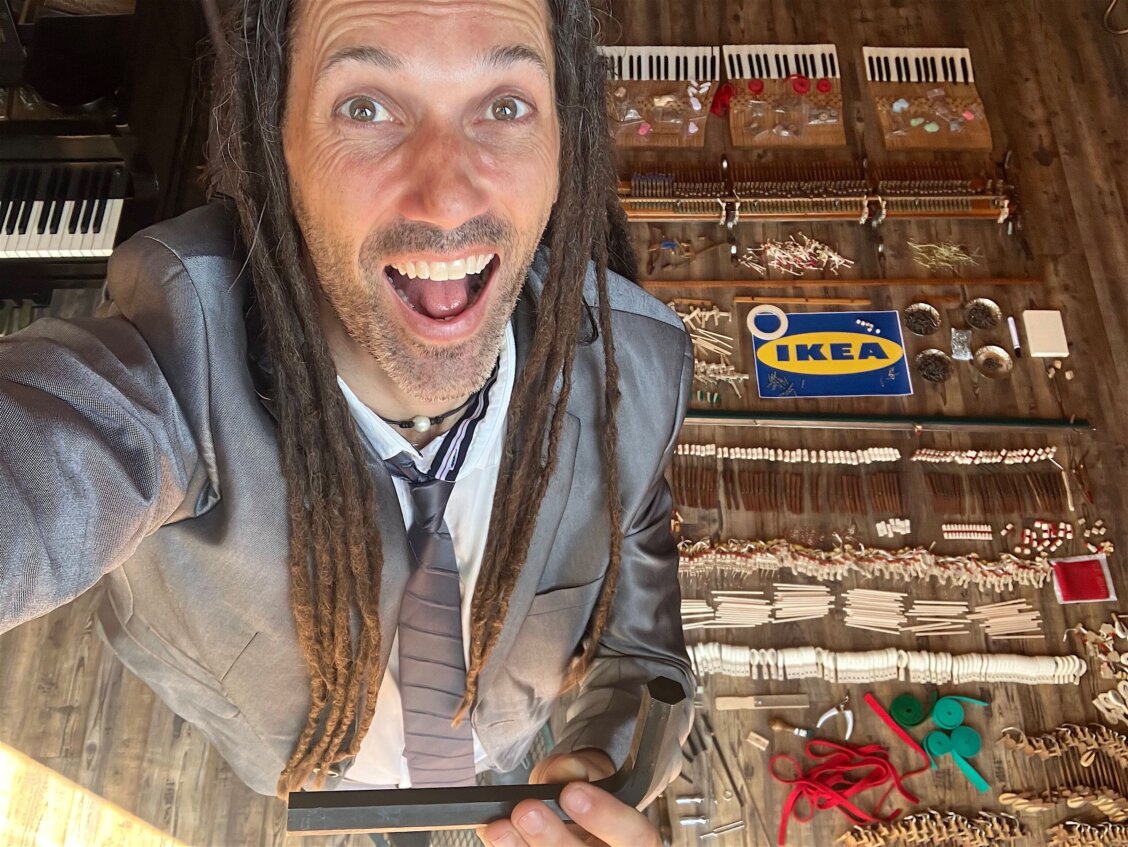Professional tuning, repairs, and maintenance for homes, schools, and churches.
310-465-6967
[email protected]
Service Areas: Pine Mountain Club, Pinion Pines, Cuddy Valley, Lake of the Woods, Lockwood Valley, Frazier Park, Lebec, Gorman, 93222, 93225, 93243, 93252
About Me
Music has always been at the core of my work, from composing and orchestrating film scores for over 25 years to maintaining and restoring fine instruments. Throughout my career I have also worked on pianos in various capacities, ensuring they sound their best for recording sessions, venues, and homes. An average piano has about 230 strings, 350 primary moving action parts, and roughly 8,000 total action parts. Just like your vehicle, pianos are active precision machines that need regular maintenance and adjustments to sound and feel their best.
Beyond traditional pianos, I also work on vintage electromechanical keyboards such as Rhodes, Wurlitzers, and Hammond organs. I also maintain and restore antique electronics, amplifiers, and some other types of recording studio gear.
I live in Pine Mountain Club and serve the surrounding mountain communities, providing professional piano care to individuals, studios, schools, churches, and anyone who values the sound of a well-maintained instrument. Whether your piano needs tuning or more in-depth repair, I am dedicated to preserving and restoring it.
Services & Rates
Standard Tuning – $200
Pitch Raise – Additional $50 (For pianos that haven’t been tuned in years and need stabilization.)
Repairs – $75/hour + parts (Includes sticking keys, regulation issues, broken parts, string replacement, and other mechanical problems.)
Hammer reshaping & voicing – Usually also requires and includes some action regulation. 4 hours average.
Comprehensive regulation – Top to bottom overhaul, alignment, and adjustment of everything that moves, often to tolerances that are fractions of millimeters. Typically includes hammer reshaping and voicing. 16 hours average.
Vintage Keyboards and Organ Repair – Contact me for an estimate (Rhodes, Wurlitzers, Hammonds, etc.)
I don’t do piano moving, but if you are moving to or from the LA area I recommend D&J Piano Movers.
Why Regular Tuning Matters
A well-tuned piano not only sounds better but also lasts longer. Over time, changes in temperature and humidity cause the strings and wooden components to shift, gradually pulling the instrument out of tune. For best results, pianos should be tuned at least once or twice a year, depending on usage and climate conditions. Regular tuning:
- Preserves the instrument’s structural integrity
- Preserves the string memory, making the tuning less susceptible to shifting
- Ensures optimal sound quality
- Prevents larger, more costly repairs down the road
- Keeps pianos at venues, schools, and churches performance-ready year-round
Common Problems & Fixes
If your piano is experiencing any of these issues, I can help restore it to proper playing condition.
Piano badly out of tune – Neglect is always the primary cause, but even if it sounds awful it still might be a minor issue. When pianos have fallen substantially flat, a quarter tone or more, tension across the soundboard and bridge shifts as the strings are brought up to pitch. The first strings tuned are therefore out of tune again by the time the last one is brought to pitch. The solution is typically to do one pass of rough tuning and another of fine tuning. Raising the pitch too much in one sitting risks breaking strings, so in very bad cases I may need to make multiple visits.
Sticking or non-responsive keys – Dust, humidity, worn-out action components, action regulation that has shifted with time, or lost objects like crayons or coins can all cause stuck piano keys. In probably half of the cases it’s a simple fix and included in my normal tuning fee. The next most likely cause is a broken action part that needs to be repaired or replaced.
Piano pedals squeak or don’t work properly – The pedals have simple adjustments, but sometimes deeper regulation is required. Occasionally some felts or rubber pieces need to be replaced. Never use WD40 on a piano squeak! Nothing in a piano is metal moving against metal, so WD40 will simply soak into wood and felt and make a mess without solving any problems.
Buzzing or rattling sounds – This is typically caused by loose hardware or deteriorating action parts in the piano that need adjustment or replacement. Those type of buzzes and rattles can be distinguished because they are separate from and additional to the piano tone. Sometimes a buzz is caused by the piano’s bridge or soundboard separating from its supports, causing distortion in a specific range of notes, and that can be more difficult to address. Those type of buzzes are distinguishable because they are meshed into the piano’s tone and distort it.
Notes sound uneven, harsh, or muted – Worn hammers and poor regulation are the most common causes. Hammers typically get grooved, hard, and harsh with use, but if exposed to humidity they can also become soft and muted. Inconsistencies of sound throughout the keyboard are usually related to poor regulation because of inconsistent movement or hammer alignment, but may simultaneously be related to the condition of the hammers.
Piano won’t stay in tune – A piano that won’t stay in tune probably suffers from something different than a badly out of tune piano. If you notice your instrument’s tuning shifting quickly, there is most likely cracking in the pinblock or bridge. The Pine Mountain Club and Frazier Mountain areas are dry, which can cause older wood to crack and shift. It may be possible to repair and stabilize cracked pinblocks and bridges in pianos without total disassembly. In very bad cases replacement is the only solution, but the majority of older pianos are not of sufficient quality to warrant the cost of a total rebuild.
